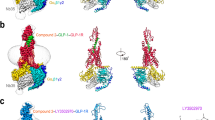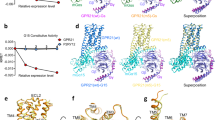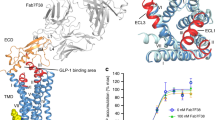Abstract
Human GPR40 receptor (hGPR40), also known as free fatty-acid receptor 1 (FFAR1), is a G-protein-coupled receptor that binds long-chain free fatty acids to enhance glucose-dependent insulin secretion1. Novel treatments for type-2 diabetes mellitus2 are therefore possible by targeting hGPR40 with partial or full agonists. TAK-875, or fasiglifam, is an orally available, potent and selective partial agonist3 of hGPR40 receptor, which reached phase III clinical trials for the potential treatment of type-2 diabetes mellitus4. Data from clinical studies indicate that TAK-875, which is an ago-allosteric modulator of hGPR40 (ref. 3), demonstrates improved glycaemic control and low hypoglycaemic risk in diabetic patients5. Here we report the crystal structure of hGPR40 receptor bound to TAK-875 at 2.3 Å resolution. The co-complex structure reveals a unique binding mode of TAK-875 and suggests that entry to the non-canonical binding pocket most probably occurs via the lipid bilayer. The atomic details of the extensive charge network in the ligand binding pocket reveal additional interactions not identified in previous studies and contribute to a clear understanding of TAK-875 binding to the receptor. The hGPR40–TAK-875 structure also provides insights into the plausible binding of multiple ligands to the receptor, which has been observed in radioligand binding6 and Ca2+ influx assay studies3. Comparison of the transmembrane helix architecture with other G-protein-coupled receptors suggests that the crystallized TAK-875-bound hGPR40 complex is in an inactive-like state.
This is a preview of subscription content, access via your institution
Access options
Subscribe to this journal
Receive 51 print issues and online access
$199.00 per year
only $3.90 per issue
Buy this article
- Purchase on Springer Link
- Instant access to full article PDF
Prices may be subject to local taxes which are calculated during checkout




Similar content being viewed by others
References
Itoh, Y. et al. Free fatty acids regulate insulin secretion from pancreatic β cells through GPR40. Nature 422, 173–176 (2003)
McGarry, J. D. & Dobbins, R. L. Fatty acids, lipotoxicity and insulin secretion. Diabetologia 42, 128–138 (1999)
Yabuki, C. et al. A novel antidiabetic drug, fasiglifam/TAK-875, acts as an ago-allosteric modulator of FFAR1. PLoS ONE 8, :e76280. (2013)
Negoro, N. et al. Discovery of TAK-875: a potent, selective, and orally bioavailable GPR40 agonist. ACS Med. Chem. Lett. 1, 290–294 (2010)
Burant, C. F. et al. TAK-875 versus placebo or glimepiride in type 2 diabetes mellitus: a phase 2, randomised, double-blind, placebo-controlled trial. Lancet 379, 1403–1411 (2012)
Lin, D. C.-H. et al. Identification and pharmacological characterization of multiple allosteric binding sites on the free fatty acid 1 receptor. Mol. Pharmacol. 82, 843–859 (2012)
Flodgren, E. et al. GPR40 is expressed in glucagon producing cells and affects glucagon secretion. Biochem. Biophys. Res. Commun. 354, 240–245 (2007)
Kotarsky, K. et al. A human cell surface receptor activated by free fatty acids and thiazolidinedione drugs. Biochem. Biophys. Res. Commun. 301, 406–410 (2003)
Shapiro, H. et al. Role of GPR40 in fatty acid action on the β cell line INS-1E. Biochem. Biophys. Res. Commun. 335, 97–104 (2005)
Hirozane, Y. et al. Generating thermostabilized agonist bound GPR40/FFAR1 using virus-like particles and label-free binding assay. Mol. Mem. Biol (in the press)
White, J. F. et al. Structure of the agonist-bound neurotensin receptor. Nature 490, 508–513 (2012)
Lebon, G. et al. Agonist-bound adenosine A2A receptor structures reveal common features of GPCR activation. Nature 474, 521–525 (2011)
Hanson, M. A. et al. Crystal structure of a lipid G protein-coupled receptor. Science 335, 851–855 (2012)
Granier, S. et al. Structure of the δ-opioid receptor bound to naltrindole. Nature 485, 400–404 (2012)
Zhang, C. et al. High-resolution crystal structure of human protease-activated receptor 1. Nature 492, 387–392 (2012)
Wu, B. et al. Structures of the CXCR4 Chemokine GPCR with small-molecule and cyclic peptide antagonists. Science 330, 1066–1071 (2010)
Wu, H. et al. Structure of the human κ-opioid receptor in complex with JDTic. Nature 485, 327–332 (2012)
Hildebrand, P. W. et al. A ligand channel through the G protein coupled receptor opsin. PLoS ONE 4, :e4382. (2009)
Mercier, R. W. et al. hCB2 ligand-interaction landscape: cysteine residues critical to biarylpyrazole antagonist binding motif and receptor modulation. Chem. Biol. 17, 1132–1142 (2010)
Hurst, D. P. et al. A lipid pathway for ligand binding is necessary for a cannabinoid G protein-coupled receptor. J. Biol. Chem. 285, 17954–17964 (2010)
Negoro, N. et al. Optimization of (2,3-dihydro-1-benzofuran-3-yl)acetic acids: discovery of a non-free fatty acid-like, highly bioavailable G protein-coupled receptor 40/free fatty acid receptor 1 agonist as a glucose-dependent insulinotropic agent. J. Med. Chem. 55, 3960–3974 (2012)
Sum, C. S. et al. Identification of residues important for agonist recognition and activation in GPR40. J. Biol. Chem. 282, 29248–29255 (2007)
Sum, C. S. et al. Two arginine-glutamate ionic locks near the extracellular surface of FFAR1 gate receptor activation. J. Biol. Chem. 284, 3529–3536 (2009)
Kruse, A. C. et al. Activation and allosteric modulation of a muscarinic acetylcholine receptor. Nature 504, 101–106 (2013)
De Lean, A. et al. A ternary complex model explains the agonist-specific binding properties of the adenylate cyclase-coupled β-adrenergic receptor. J. Biol. Chem. 255, 7108–7117 (1980)
Katritch, V. et al. Structure-function of the G protein-coupled receptor superfamily. Annu. Rev. Pharmacol. Toxicol. 53, 531–556 (2013)
Rasmussen, S. G. F. et al. Crystal structure of the β2 adrenergic receptor-Gs protein complex. Nature 477, 549–555 (2011)
Rasmussen, S. G. F. et al. Structure of a nanobody-stabilized active state of the β2 adrenoceptor. Nature 469, 175–180 (2011)
Standfuss, J. et al. Crystal structure of a thermally stable rhodopsin mutant. J. Mol. Biol. 372, 1179–1188 (2007)
Choe, H. W. et al. Transmembrane signaling by GPCRs: insight from rhodopsin and opsin structures. Neuropharmacology 60, 52–57 (2011)
Rosenbaum, D. M. et al. GPCR engineering yields high-resolution structural insights into β2-adrenergic receptor function. Science 318, 1266–1273 (2007)
Caffrey, M. & Cherezov, V. Crystallizing membrane proteins using lipidic mesophases. Nature Protocols 4, 706–731 (2009)
Cherezov, V. et al. Rastering strategy for screening and centring of microcrystal samples of human membrane proteins with a sub-10 µm size X-ray synchrotron beam. J. R. Soc. Interface 6, S587–S597 (2009)
Fischetti, R. F. et al. Mini-beam collimator enables microcrystallography experiments on standard beamlines. J. Synchrotron Radiat. 16, 217–225 (2009)
Otwinowski, Z. & Minor, W. Processing of X-ray diffraction data collected in oscillation mode. Methods Enzymol. 276, 307–326 (1997)
Evans, P. R. Scaling and assessment of data quality. Acta Crystallogr. D 62, 72–82 (2006)
McNicholas, S. et al. Presenting your structures: the CCP4mg molecular-graphics software. Acta Crystallogr. D 67, 386–394 (2011)
Vagin, A. & Teplyakov, A. Molecular replacement with MOLREP. Acta Crystallogr. D 66, 22–25 (2010)
Emsley, P. & Cowtan, K. Coot: model-building tools for molecular graphics. Acta Crystallogr. D 60, 2126–2132 (2004)
Vagin, A. A. et al. REFMAC5 dictionary: organization of prior chemical knowledge and guidelines for its use. Acta Crystallogr. D 60, 2184–2195 (2004)
Chen, V. B. et al. MolProbity: all-atom structure validation for macromolecular crystallography. Acta Crystallogr. D 66, 12–21 (2010)
Acknowledgements
We thank K. P. Wilson, M. Hixon and K. Goodwill for review and feedback on the manuscript; T. Ho and S. Okubo for molecular cloning support; T. Sjoberg for membrane preparation; and C. Dillard for cell culture support. We also thank the staff of the Berkeley Center for Structural Biology, Lawrence Berkeley National Laboratory, which operates Advanced Light Source beamline 5.0.3, and the staff of GM/CA, Argonne National Laboratory, which operates Advanced Photon Source beamline 23ID-D. The Berkeley Center for Structural Biology is supported in part by the National Institutes of Health and National Institute of General Medical Sciences. The GM/CA has been funded in whole or in part with Federal funds from the National Cancer Institute (Y1-CO-1020) and the National Institute of General Medical Sciences (Y1-GM-1104). The Advanced Light Source and Advanced Photon Source are supported by the Director, Office of Science, Office of Basic Energy Sciences of the US Department of Energy under contract numbers DE-AC02-05CH11231 and DE-AC02-06CH11357, respectively.
Author information
Authors and Affiliations
Contributions
A.S. guided construct and expression optimization, developed purification procedures and purified receptor protein, characterized crystallization constructs, performed crystallization and structure analysis, and was responsible for project strategy. J.Y. performed crystallization and crystal harvesting, structure determination and structure analysis. Y.H. performed mutant screening and characterized mutants and crystallization constructs. G.S. and W.L. performed data collection, data processing and structure analysis. G.K. performed molecular biology, construct optimization and expression screening. F.G. performed construct characterization, protein purification and crystallization. K.A. guided construct optimization and performed molecular biology. A.J. and A.I. performed homology modelling to aid molecular refinement. A.J. discussed ligand-binding site in the structure. J.N. performed protein purification and crystallization; K.O. supported experimental design and data discussion for mutant screening. F.G., A.S., J.Y., G.K., G.S. and W.L. prepared the figures. All the authors contributed to manuscript writing.
Corresponding author
Ethics declarations
Competing interests
The authors declare no competing financial interests.
Extended data figures and tables
Extended Data Figure 1 Crystallization construct and crystallization drop image.
a, Snake-plot diagram of the hGPR40 expression construct. The affinity tags and the linker at the insertion of T4L are shown in blue. Thermostabilizing mutations are shown in red. b, Cartoon representation of the hGPR40–TAK-875 structure with the mutations highlighted in red. c, Crystals obtained in lipidic cubic phase could be observed using circularly polarized light.
Extended Data Figure 2 LC–MS-based TAK-875 binding to hGPR40 crystallization constructs.
Panels above show TAK-875-specific binding to the WT receptor, the quadruple mutant with T4L insertion and the T4L-inserted quadruple mutant with GS linker. The last construct corresponds to the crystal structure. The table summarizes the binding affinity of WT and modified constructs, which remains in the range 12–16 nM. ▵, Specific binding; ○, total binding; □, Sf9 control membranes; n = 3; s.e.m., standard error of the mean.
Extended Data Figure 3 Comparison of ligand-binding-pocket access.
hGPR40 (white), δ-opioid (orange) and S1P1 (purple) are compared for access to the ligand binding pocket. The extracellular view of the accessible surface (a, d, g) reveals that unlike δ-opioid, which has the canonical solvent-accessible binding pocket, S1P1 and hGPR40 ligand access is obscured by extracellular loops. From a lateral view (b, e, h) in the plane of the membrane, TAK-875 entry to hGPR40 is distinct from the other receptors. S1P1 ligand accessibility is also seen from a lateral view (c, f, i) in the plane of the membrane; however, the position is ∼120° rotated in the plane of the membrane. The accessible views observed for hGPR40 (b), δ-opioid (d) and S1P1 (i) are illustrated as ribbons with ligands as sticks (k, j, l respectively).
Extended Data Figure 4 Comparison of ECL2 among peptide-binding receptors and the related hGPR40.
a, ECL2 between transmembrane 4 and transmembrane 5 of hGPR40 (grey) shares the short hairpin loop region and disulphide tether to transmembrane 3 seen previously only in the peptide-binding receptor family members NTSR1 (green), PAR1 (cyan), δ-opioid (purple) and CXCR4 (orange). Auxiliary loop of hGPR40 is shown in pink colour in ECL2 region. b, Structure-based alignment of transmembrane 4, transmembrane 5 and the hairpin loop reveal very low sequence identity despite the conserved structural features. A conserved Trp in transmembrane 4, a conserved Pro in transmembrane 5, and the Cys involved in the disulphide bond to transmembrane 3 are the only conserved residues. hGPR40 residues coloured in pink correspond to the auxiliary loop of ECL2 shown in a.
Extended Data Figure 5 The ECL2 loop.
Top (a) and lateral (b, c) views of the ECL2 loop to highlight polar interactions (left) and B-factors (right) of ECL2 residues. The interactions are shown as black dotted lines (left) and TAK-875 is green. ECL2 is shown in cyan with residue side chains in the left, and as a ribbon cartoon on the right, with the ribbon’s thickness and colour scaled according to the B-factors (ranging from 34 Å2 shown in blue to 88 Å2 shown in red within the ECL2 loop). The numerous polar interactions within the ECL2 loop and with water molecules and residues outside of the ECL2 loop, in addition to the disulphide-bond to transmembrane 3, stabilize this region to a large extent. This is reflected in the B-factors, which show relatively low mobility for most of the ECL2 loop. (Inside, intracellular side; outside, extracellular side.)
Extended Data Figure 6 TAK-875 interactions with hGPR40 based on the computational chemistry program MOE.
The figure above illustrates the colour code and bonding interaction based on the crystal structure. The carboxylic acid is buried within a very hydrophobic region where it makes ionic/polar interactions with Arg 1835.39, Arg 2587.35, Tyr 913.37 and Tyr 2406.51 while the other end of the molecule is exposed outside the receptor.
Extended Data Figure 7 Evaluation of LC–MS-based TAK-875 binding to WT and binding-pocket residue mutants of WT hGPR40.
Panels above show TAK-875-specific binding to the WT receptor and the WT receptor containing single point mutations of binding-pocket key residues. Table summarizes the measured binding affinity of WT and single point mutants. ▵, Specific binding; ○, total binding; □, VLP control membranes; n = 3; s.e.m., standard error of the mean.
Extended Data Figure 8 Evaluation of LC–MS-based TAK-875 binding to WT and thermostabilized receptor binding-pocket residue mutants of hGPR40.
Panels above show TAK-875 specific binding to the WT receptor and thermostabilized receptor containing single point mutations of binding-pocket key residues. Table summarizes the measured binding affinity of WT and single point mutants. ▵, Specific binding; ○, total binding; □, VLP control membranes; n = 2; s.e.m., standard error of the mean.
Rights and permissions
About this article
Cite this article
Srivastava, A., Yano, J., Hirozane, Y. et al. High-resolution structure of the human GPR40 receptor bound to allosteric agonist TAK-875. Nature 513, 124–127 (2014). https://doi.org/10.1038/nature13494
Received:
Accepted:
Published:
Issue Date:
DOI: https://doi.org/10.1038/nature13494
This article is cited by
-
Bitter taste receptor activation by cholesterol and an intracellular tastant
Nature (2024)
-
Structural basis of omega-3 fatty acid receptor FFAR4 activation and G protein coupling selectivity
Cell Research (2023)
-
Structural identification of lysophosphatidylcholines as activating ligands for orphan receptor GPR119
Nature Structural & Molecular Biology (2022)
-
Identification of behenic acid as medicinal food for the diabetes mellitus: structure-based computational approach and molecular dynamics simulation studies
Journal of Molecular Modeling (2022)
-
Ligand binding at the protein–lipid interface: strategic considerations for drug design
Nature Reviews Drug Discovery (2021)
Comments
By submitting a comment you agree to abide by our Terms and Community Guidelines. If you find something abusive or that does not comply with our terms or guidelines please flag it as inappropriate.



